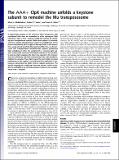The AAA+ ClpX machine unfolds a keystone subunit to remodel the Mu transpososome
Author(s)
Baker, Tania; Abdelhakim, Aliaa H.; Sauer, Robert T
DownloadAbdelhakim-2010-The AAA plus ClpX ma.pdf (748.4Kb)
PUBLISHER_POLICY
Publisher Policy
Article is made available in accordance with the publisher's policy and may be subject to US copyright law. Please refer to the publisher's site for terms of use.
Terms of use
Metadata
Show full item recordAbstract
A hyperstable complex of the tetrameric MuA transposase with recombined DNA must be remodeled to allow subsequent DNA replication. ClpX, a AAA+ enzyme, fulfills this function by unfolding one transpososome subunit. Which MuA subunit is extracted, and how complex destabilization relates to establishment of the correct directionality (left to right) of Mu replication, is not known. Here, using altered-specificity MuA proteins/DNA sites, we demonstrate that transpososome destabilization requires preferential ClpX unfolding of either the catalytic-left or catalytic-right subunits, which make extensive intersubunit contacts in the tetramer. In contrast, ClpX recognizes the other two subunits in the tetramer much less efficiently, and their extraction does not substantially destabilize the complex. Thus, ClpX targets the most stable structural components of the complex. Left-end biased Mu replication is not, however, determined by ClpX’s intrinsic subunit preference. The specific targeting of a stabilizing “keystone subunit” within a complex for unfolding is an attractive general mechanism for remodeling by AAA+ enzymes.
Date issued
2009-09Department
Massachusetts Institute of Technology. Department of BiologyJournal
Proceedings of the National Academy of Sciences of the United States of America. (PNAS)
Publisher
National Academy of Sciences (U.S.)
Citation
Abdelhakim, Aliaa H., Robert T. Sauer, and Tania A. Baker. “The AAA+ ClpX machine unfolds a keystone subunit to remodel the Mu transpososome.” Proceedings of the National Academy of Sciences 107.6 (2010): 2437 -2442. © 2011 by the National Academy of Sciences
Version: Final published version
ISSN
0027-8424
1091-6490